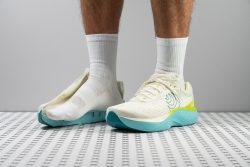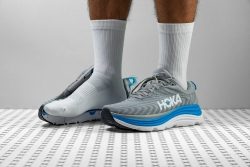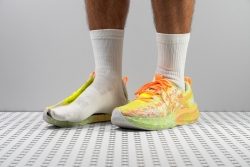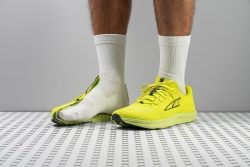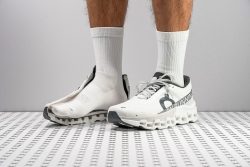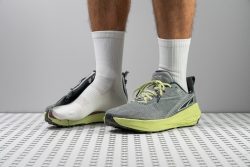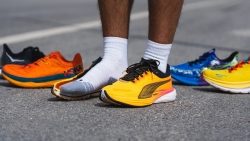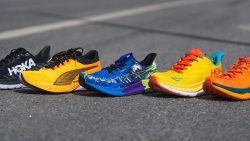7 Best Running Shoes For Bunions in 2025
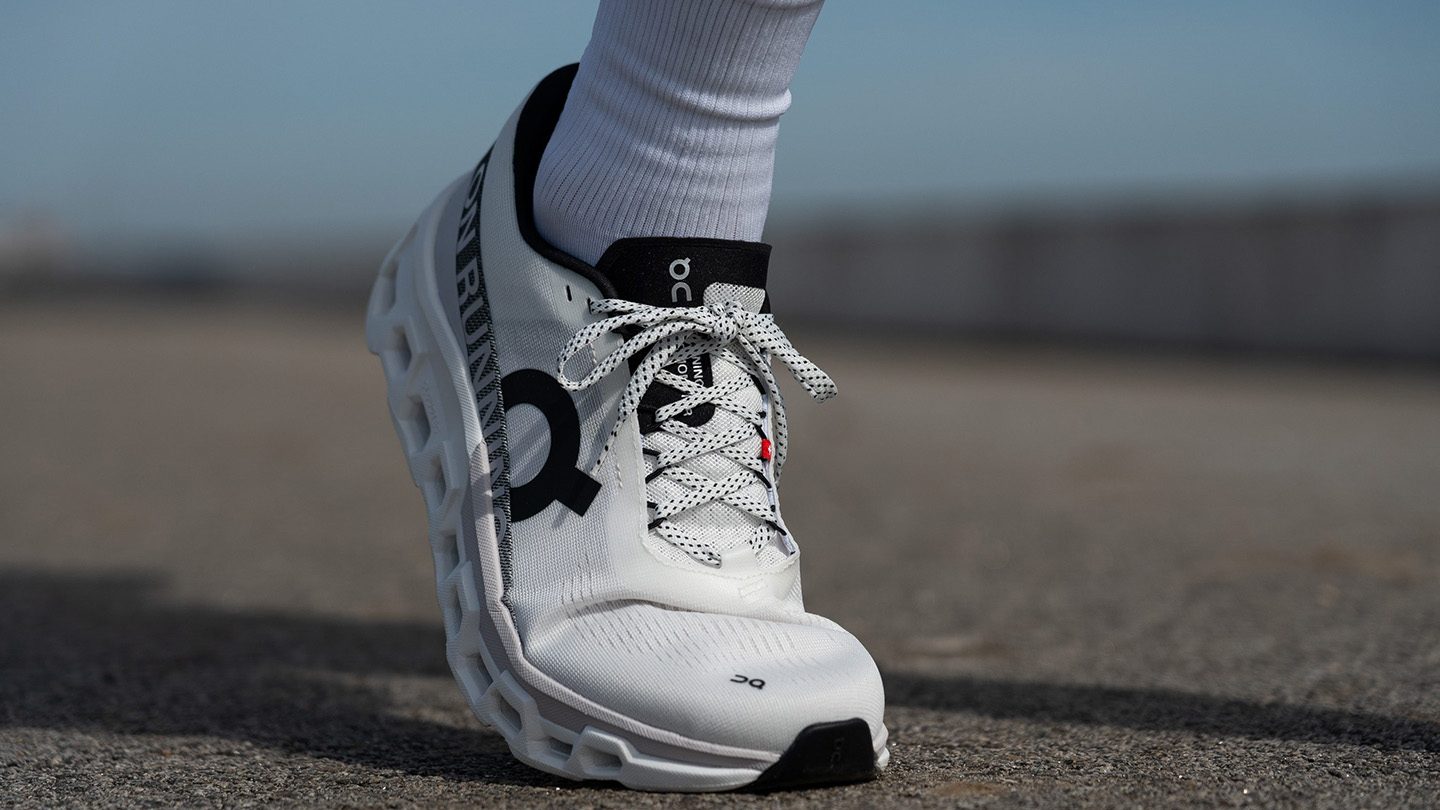
We buy shoes ourselves. We earn commissions when you buy through us, at no extra cost. Why trust us
Bunions, or bony bumps, ask for a wide toebox that does not put pressure on them. This usually means running shoes should have high-volume toeboxes and the volume of the toebox is exactly what we measure in our lab.
We use 3 data points to quantitatively describe each toebox and this, along with our running expertise and other lab tests, allows us to highlight the best running shoes for bunions in various categories.
How we test running shoes for bunions
There's no brand or marketing campaign that tells us what to write or what not to write. We have our own process for deciding which shoes to test, and then we buy them using our own money. We have no brand ambassadors on the team.
Each shoe is treated the same. We perform test runs and make sure to test shoes in different weather conditions and over varying terrain, be it road, trail, mud, rocks, both wet and dry.
Then, we test the shoes in our lab. We use calipers, durometers, smoke machines, a freezer, and other devices to measure and describe different features accurately. All our results are published in a way that allows our readers to compare them with averages or results from other shoes of their choice.
Our approach allows us to publish the most objective reviews out there. The top picks that we put under the spotlight here have performed the best in different categories when bunions are taken into account.
Best running shoes for bunions overall
















































What makes it the best?
We confidently claim the Topo Atmos as the top running shoe for those with bunions. Visually, its anatomical toebox is already evident, yet it’s the comfort we experienced during our runs and the numbers we measured in the lab that solidify our choice. Not only that, it can go the distance with its impact protection and forgiving ride.
Topo Atmos offers one of the critical components of a good bunion running shoe, and that’s a majorly wide toebox. We had zero pressure points on our feet, since the front barely tapers. Built with our natural foot anatomy in mind, the toebox measures 85.0 mm wide, while the average is only 73.3 mm.
Each landing feels significantly well-cushioned, which helps reduce strain on our feet. The stack height measures an above-average 37.8/32.5 mm, offering impressive levels of shock absorption in the heel (130 SA) and in the forefoot (122 SA).
Testing for flexibility, Atmos earned a middle-of-the-road score of 15.1N. This makes it flexible enough for comfort and daily wear without being too mobile, which may lead to further injuries.
However, its broad dimensions still make us feel less agile on the road. Those who prefer a lighter feel should explore other options.
Pros
- Max-cushioned comfort
- Ultra-spacious toebox
- Stable ride
- Premium Ortholite footbed
- Midfoot-friendly geometry
- Lightweight for its huge size
- Great for easy long runs
- No heel slippage
Cons
- Lacks energy return
- Not for narrow-footed runners
- Could be a bit more flexible
Running shoes for bunions with the best stretchy upper
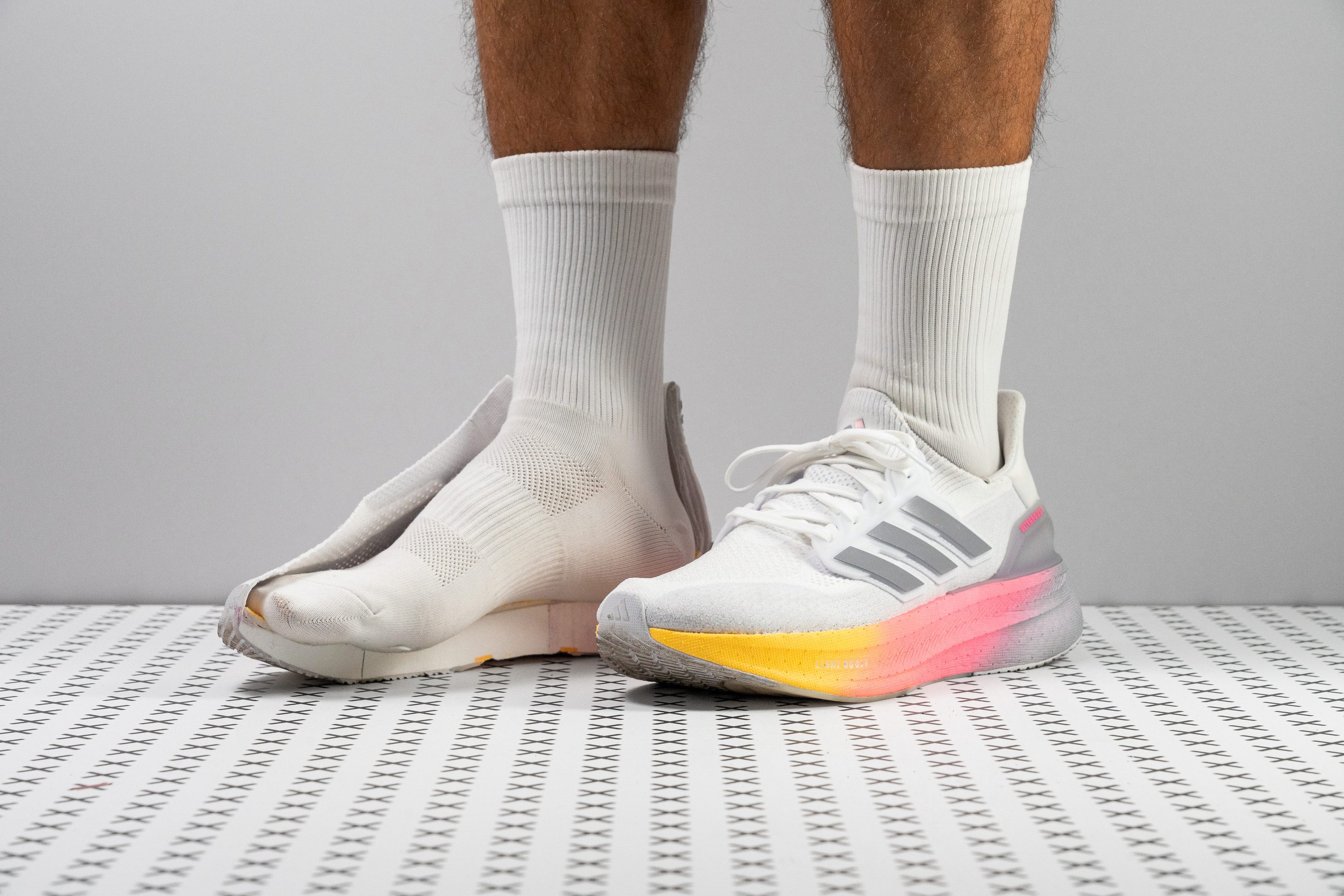



















































What makes it the best?
Wider than average AND equipped with a super-stretchy upper? Yes, that's the Ultraboost 5 and that's the shoe with the best possible upper for those who have bunions. It's gentle, it's stretchy, it it's roomy, so basically, all you could ask for!
To understand how a shoe fits, we have to understand its volume. Our gel tests allow us to do just that: we pour a liquid into the shoe, put the shoe into the freezer, and after 2 hours, we have a mold of the shoe's interiors! This is GREAT because it allows us to measure the exact width of the shoe. There's no other way of doing it because we can't stick a laser or a caliper into the upper and take into account the stretchiness. At 98.4 mm, the Ultraboost 5 is wider than the average. Just what we need when dealing with the bunions. But, there's more.
Looking at the toebox, it is 78.6 mm wide. That's 5mm wider than what we usually encounter in running shoes! This is very important because bunions don't need room only where they protrude, but also in the toebox. Narrow toeboxes press the big toe towards the pinky toe and make things even worse. Adidas Ultraboost 5 offers a roomy toebox, so on the way to recovery, the big toe can enjoy more room and no pressure from the sides!
What blew our minds was just how amazing this upper is. Even though it's made of knit, it still scored 3/5 on our durability test! Very good for a knit upper. And, even better for a superbly breathable one! It scored a perfect 5/5 on our breathability test, which means it is as breezy as it gets. Perfect for hot weather and sweaty feet.
If you're looking for a running shoe for tempo sessions, fartlek, or even racing, skip this one. This is a daily trainer and that's what it shines at!
Pros
- Enhanced midsole cushioning
- Roomy, comfortable knit upper
- Suitable for daily wear
- Excellent durability
- Optimized for heel strikers
- Superior Continental outsole
- More cushioned than ever before
- Can handle forefoot strikers
- Great for summer
Cons
- Could still be lighter
- Not suitable for fast paces
- Potential for heel slippage
Best stability running shoes for bunions

















































What makes it the best?
If bunions could talk, they would ask for a gentle upper, room to splay, and a platform and fit that do not make the feet overwork. Hoka Gaviota 5 delivers on all front which is why we found it to be the best stability running shoe for bunions.
Gaviota 5 features a wide and stable platform (it is 16 mm wider than the average!), and the extra support comes from the dual-density midsole. The main foam is significantly softer than the average. Our durometer showed 12.9 HA (the average is around 20 HA). But, there's another foam that is firmer (22 HA) and placed in the shape of a letter H (although we think it's shaped as a number 8) at the tip of the shoe, under the arch, and at the back. This way, the heel and the ball of the foot land on the softer foam, while the firmer one acts as a stabilizing cage. And it works like a charm for those who overpronate or have flat feet.
Looking at the extra room that we need when dealing with bunions, Gaviota 5 delivers them both where the shoe is the widest and at the big toe (in the toebox). In both places, Gaviota 5 is ~4 mm wider than the average! Talk about extra space.
If you're a heel striker, be warned that this is a low-drop shoe. With a heel drop of 2.2 mm (no, it's not 6.0 mm as Hoka claims), you may find it challenging to run in this shoe and a transition period should be taken into account.
Pros
- Remarkably stable
- Breathable and comfortable upper
- Lightweight for its size
- Good stability option for forefoot strikers
- Ideal for wide feet
- Excellent for long runs
Cons
- Low drop might pose issues for heel strikers
- Performs poorly in colder conditions
- Not for narrow feet
- Midsole feels flat
Best tempo running shoes for bunions






















































What makes it the best?
The ASICS Noosa Tri 16 offers a refreshing ride through its airy mesh upper, delivering sockless comfort and seamless ventilation. It has a light and flexible build that keeps us quick and agile, making it our top tempo shoe for runners with bunions. Not to mention, its tall and wide toebox assures we won’t have to deal with any rubs and pressure points even as our feet swell.
Noosa Tri 16 is easy to maneuver, with its figure on the scale at 7.7 oz (217g). Being 18.1% below average, it never felt like a burden during faster efforts. Meanwhile, the midsole bends with our feet freely, emerging 3.3% more pliable than average.
The toebox has a very subtle taper, proven by its broad 77.3 mm width vs. the 73.3 mm average. Not only does it have additional space on the sides, but extra vertical room as well, with an impressive height of 31.2 mm vs. the 27.1 mm average. In all directions, this shoe accommodated us well.
The light engineered mesh upper also does its job of making sure we feel comfortable. It feels good on the feet even without socks, and guarantees we won’t have hotspots because of its strong airflow. Our smoke test backs us up with a perfect 5/5 breathability score.
The tradeoff for maximum ventilation is the upper’s durability. It surrendered easily to our Dremel, so if longevity is a must, we recommend going for a more reinforced shoe.
Pros
- Lightweight
- Exceptional grip
- Attention-grabbing aesthetic
- Gusseted tongue
- Comfortable upper
- Great for triathlon
- Really versatile
- Fantastic price point
- Breathability
Cons
- Upper longevity
- Minimal tongue padding
- Still not enough energy return
Best minimalist running shoes for bunions


















































What makes it the best?
Bunions can happen to anyone, and they are not a foot condition that requires super stiff, orthopedic surgeon-recommended shoes. The opposite: All feet deserve the best, and for some, that's a minimalist shoe. There are many benefits of minimalist shoes, and strengthening the foot muscles is one of them. We found this to be very valuable for feet dealing with bunions and Altra Escalante 4 is our top pick in the world of minimalist running shoes!
A few things make the Escalante 4 such an excellent minimalist shoe. First, its stack height. With only 23.8 mm at the heel, it is more than 10 mm lower than the average running shoe. It is really low to the ground. Then, the drop. Although the brand claims it's a zero-drop shoe, we discovered an offset of 1.4 mm. Still, not bad! Actually, it's ~7mm less steep than the average running shoe and this is THE feature to love the Escalante 4.
This low heel drop makes the foot muscles work more than the muscles of the upper legs. Minimalist shoes can be very helpful in strengthening the lower legs to the point of helping with some injuries because your feet become stronger. It's just very important to gradually adjust to them!
To make sure it offers a natural-feeling ride, Escalante 4 had to be flexible. And it is! 83% more flexible than the average running shoe. Talk about bending the shoe naturally together with your feet!
And why do we love it so much for bunions? Well because it features a very spacious toebox. The shoe itself is more than 5mm wider than the average and then, looking at the toebox, there's 9mm more than you could find in the average running shoe. So, the bunions will have room at the big toe joint and the toebox won't push the big toe toward the pinkie one. Isn't that the whole point of having bunion-friendly footwear?
If your big toe is pointing up, you may want to look elsewhere. The average toebox height is 27.2 mm and the Escalante 4 got only 25.4 mm. While it may seem like a small difference, sometimes 1-2 mm can really mean the difference between all good and black toenails.
Pros
- Minimalist, flexible ride
- Outstanding outsole
- Spacious extra-wide toebox
- Superb stability
- Lightweight
- Highly durable upper
- Recaptures Escalante 1.5 vibes
Cons
- Poor ventilation
- Non-gusseted tongue
- Not ideal for long distance training
Running shoes for bunions with the best shock absorption
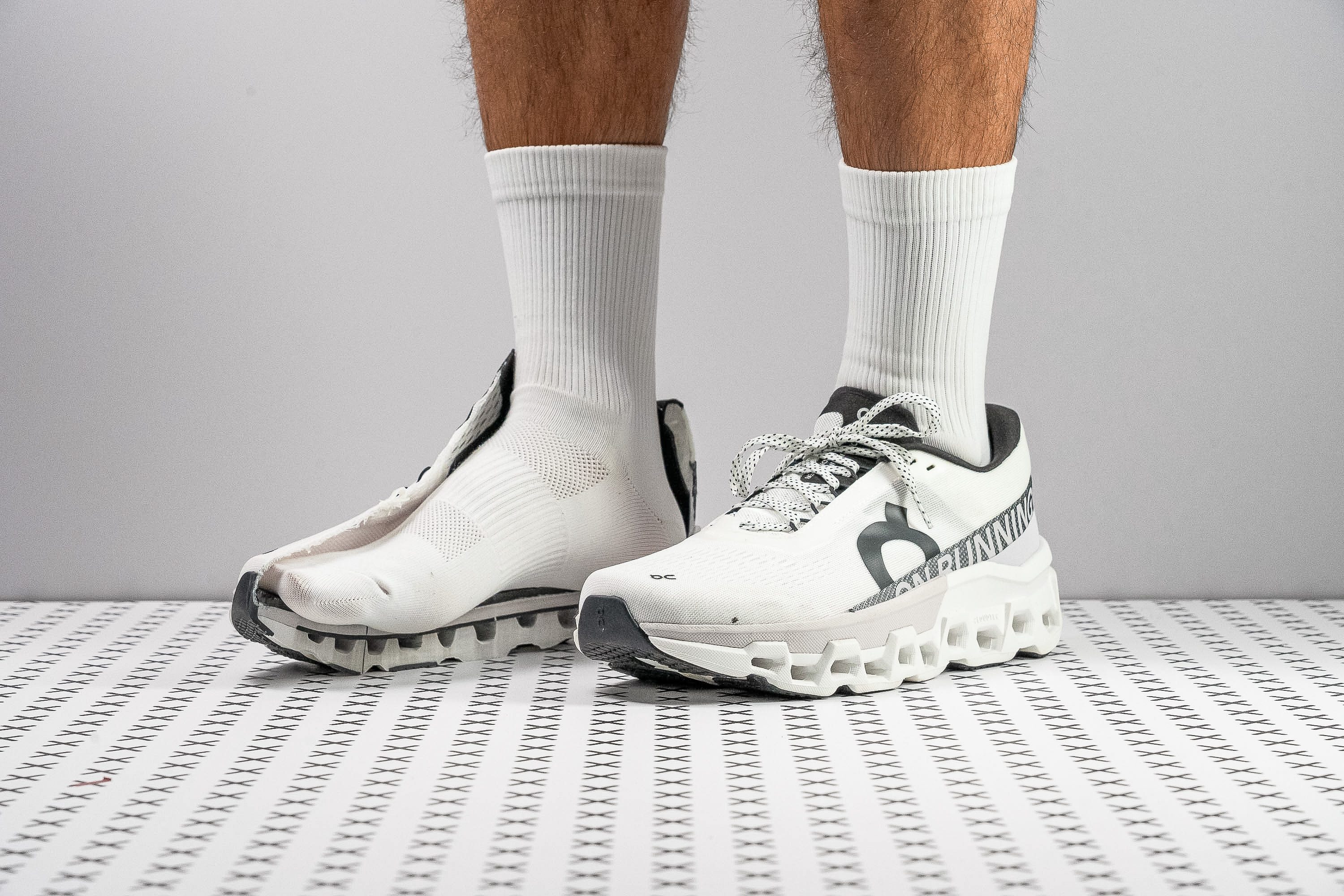























































What makes it the best?
Longer distances mean your feet are working a lot, maybe even in the hot weather, and that means swelling. What do runners with bunions need for longer distances then? A shoe with a generous interior, gentle upper, and cushioning that absorbs shock for miles and miles! Which shoe delivers that better than the rest? On Cloudmonster 2!
37.9 mm of heel stack height! While it's not massive, we discovered it's actually perfect for building up the mileage and heel strikers. Height alone does not mean a lot, but when we add the fact that it's a dual-density midsole with a softness of 26.5 HA and 40 HA, and that the shoe features the CloudTec technology, all of it together results in a softer-than-numbers-show feel, a lot of impact protection, and a ride that feels good for miles. The proof? We recorded an impressive shock absorption of 137 SA.
When covering long distances, many things can happen, including a change of weather. Fortunately, on the grip test (we follow the SATRA TM144 test method), On Cloudmonster 2 scored 0.50. This means that it grips both wet and dry surfaces well, so no worries if a rainy cloud appears out of nowhere! Keep running!
The average width of road running shoes we've tested so far is 95.3 mm. On Cloudmonster 2 is 98.5 mm wide! Not an Altra/Topo shoe, but still, it is wide and it feels roomy all over, not just in one place. Its toebox is also wider than the average at 74.5 mm. This room is super valuable for runners who have bunions or bunionettes.
When we pump the smoke into the toebox, we assess the shoe's breathability. Cloudmonster 2 scored rather low: only 2 out of 5. This means it's better for colder weather than long summer days. Because of this, we recommend that you skip it if you have very sweaty feet or you always run in very warm weather. Thin socks can only do so much when doing an LSD.
Pros
- Premium materials
- Enhanced cushioning from v1
- Roomy toebox
- Works fantastic for midfoot strikers
- Unique ride feel
- Excels in long runs
- Solid stability
Cons
- Breathability needs improvement
- Tongue lacks enough cushion
- Needs to lose a bit of weight
- Not enough energy return
Best trail running shoes for bunions
















































What makes it the best?
Altra Experience Wild is a wild (see what we did there?) combination of a) cushioning that works both for running and hiking, b) grip, and c) a roomy fit that turns out to be perfect for bunions! There was nothing else we could do but highlight it as our #1 pick for trails for runners who have bunions.
Altra shoes used to be minimalist, featuring a zero drop. Not anymore! With 34.5 mm at the heel, this is a very cushioned trail shoe! And, its drop is 4.3 mm. The average for trail shoes sits around 7.5 mm, so it is lower than that but still higher than what Altra used to deliver (0 mm). And this is great for runners who do not want to immediately switch to a zero drop (or at all). The non-zero drop and the cushioned platform are very kind to our feet, and when troubled with bunions, we really enjoy the ride.
Once we cut the Experience Wild in half, we were able to measure the thickness of the lugs with a digital caliper. At 3.6 mm, this shoe sits at the average, meaning it's perfect for moderate and light trails.
But, it's not all just about the ride, it's also about the fit. Runners with bunions need more room at the big toe joint, those with bunionettes need room at the pinkie toe joint, and all runners with bunions need room to splay. Toes must not be cramped in the toebox! With 98.8 mm of width, Altra is quite wider than the average. But, it's even wider (than the average) at the toebox. Our digital caliper showed 79.3 mm, which is almost 5 mm wider. This fit offers more room for the bunions but it is not so wide that it makes the foot slide inside or cause an impossible lockdown.
We mentioned this shoe is not meant for technical terrain, but if the terrain you plan to cover often includes small pebbles and debris, we recommend wearing the gaiters. The heel collar is rather low and the debris finds the way to the shoes' interiors very easily.
Pros
- Exceptionally roomy toebox
- Good transition shoe towards zero drop
- Ultra-plush tongue for top comfort
- Well cushioned for long adventures
- Versatile for hiking and running
- Good stability for heel strikers
- All-around durability
- Compatible with external gaiters
- Reasonable price
Cons
- Midsole lacks energy return
- Low heel collar allows debris in
- Non-gusseted tongue
- Not for narrow feet
This guide is here to educate, not make a medical diagnosis. If you’re experiencing pain or noticing anatomical differences in your feet, schedule an appointment with a podiatrist.
When the big toe is pushed towards the pinky toe, the joint at the base of the big toe protrudes. We see that as a bony bump on the inner side of the foot, and we call it a bunion or hallux valgus. In many cases, this happens due to ill-fitting footwear with very narrow (pointy) toeboxes.

Due to that pressure on the big toe, the metatarsophalangeal (MTP) joint becomes misaligned, so the tip of the big toe starts pointing to the pinky toe, sometimes it even overlaps with other toes, and the first metatarsal bone shifts outward so that its tip points toward the opposite foot.
Bunions or big toe arthritis: similarities and differences
Both of these conditions happen at the metatarsophalangeal joints and, although they can look similar, they are not the same. It’s important to make the difference between them so that you know what you’re dealing with.

|
Hallux valgus or bunions |
Hallux rigidus or big toe arthritis |
|
Both happen at the base of the big toe (MTP joint) |
|
|
In both cases, it’s imperative to start treatment ASAP |
|
|
One person can have both of these conditions. |
|
|
Many other consequences, including limited big toe movement. |
Progressive, from limited motion of the big toe to a complete lack of motion |
|
A deformity that happens as a consequence of extra pressure on the big toe that pushes it out of its natural alignment and towards the other toes. |
A form of degenerative arthritis |
|
Usually hurts less than hallux rigidus and can be pain-free, especially at the beginning |
Tends to hurt more and have a bigger impact on the (lack) of big-toe motion |
|
Hurts because soft tissue on the joint is rubbing the inside of the shoe |
Hurts because a bone spur is limiting the motion or because there are loose bone pieces that detached from the bone spur and got trapped in the joint |
Why it’s important to find proper footwear for bunions sooner rather than later
Not just footwear. It’s always best to visit a specialist who will make proper diagnosis and recommendations. From icing, taping, physiotherapy and corticosteroids to painkillers (NSAIDs) and surgery.
|
It’s imperative to pay attention to the bunions as soon as you notice them because they do not go away on their own. |
If you keep ignoring them, they might lead to: limited big toe movement, pain when standing, walking, and/or exercising, corns or calluses, numbness, swelling, bursitis, hammertoes, and osteoarthritis.

In this guide, we focus on running shoes. It is worth noting that many runners with bunions found Crocs and Birkenstocks comfortable for casual walking.
Say NO to these if you have bunions
Before we continue, the biggest step you can take right now if you have bunions is to ditch:
- High heels
- Shoes with pointy toeboxes
6 things to look for in running shoes if you have bunions
- Wide toebox: non-negotiable! This is especially important because many female runners actually need just a wide toebox and not a wide shoe overall. They should look for a wide toebox and not a shoe in Wide or Extra wide.
- Tall toebox. Not many runners think about this, but having vertical room matters as well as your toes should not be pressed on from any direction.
- Stretchy upper. Stiff upper could put more pressure on the bunion. Soft, pliable, knit upper is the way to go!
- Comfort. No hot spots, no sliding within the shoe, no heel slipping. Dreamy comfort is what you should be looking for!
- Arch support. There are contradictory opinions on this and we will cover both sides.
- Cushioned platform. Some runners actually enjoy barefoot running shoes instead of high-stacked ones and we will explain the use cases for both. Data (scientific research) is not uniform on this topic.
Out of these 6, numbers 1, 2, and 3 are insanely important if you also have bunionettes or tailor’s bunions (smaller bunions below your pinkie toe).
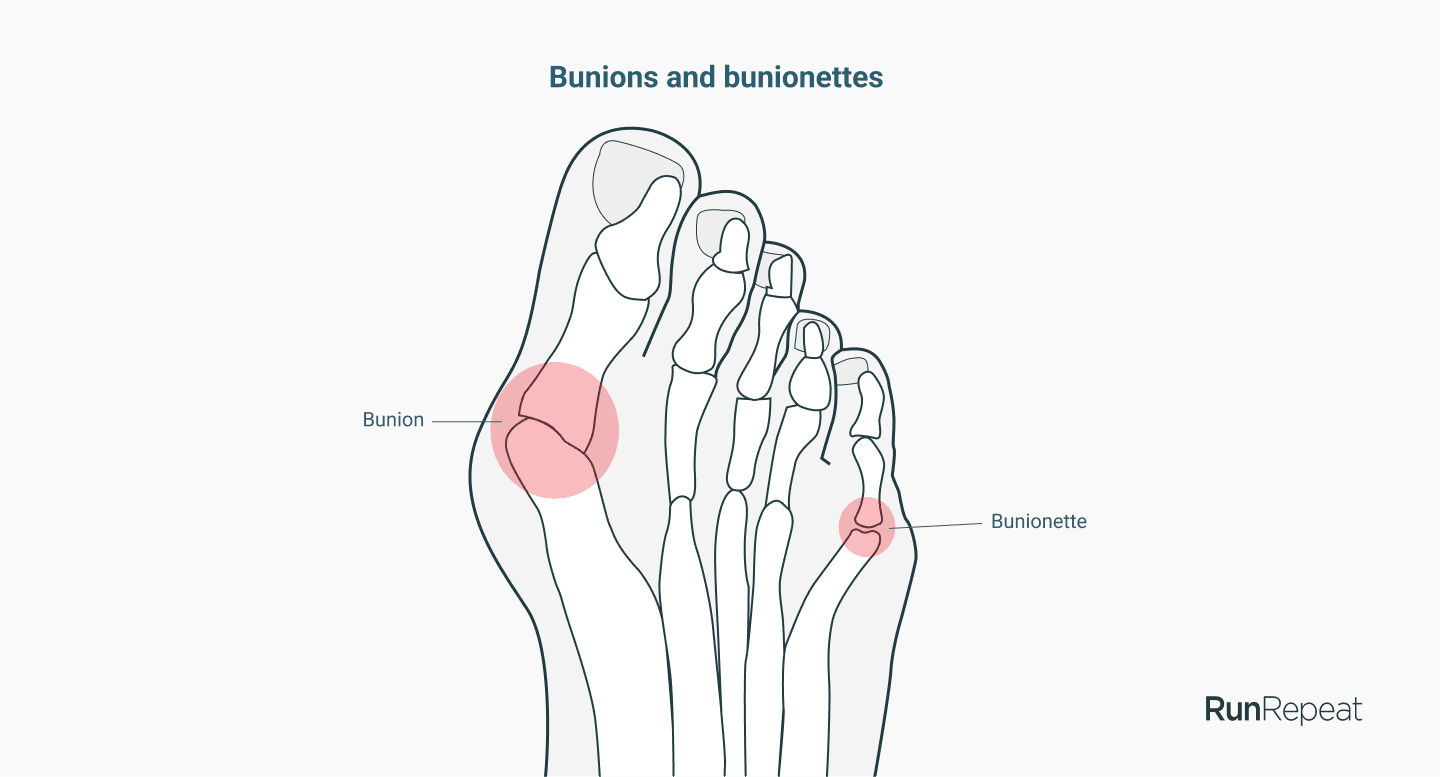
Finding a wide toebox
Finding the best toebox for the bunions is much easier when you know we measure the width of the shoe in 2 places: where it’s the widest and at the big toe. Given that bunions can happen when inadequate footwear (very pointy) pushes the big toe towards the pinky toe, we know that you need room at the big toe.
In our lab, we pour our special gel into the shoe. The gel fills the shoe entirely, so we put them in the fridge for 2 hours to be able to measure the inner volume of the shoe accurately
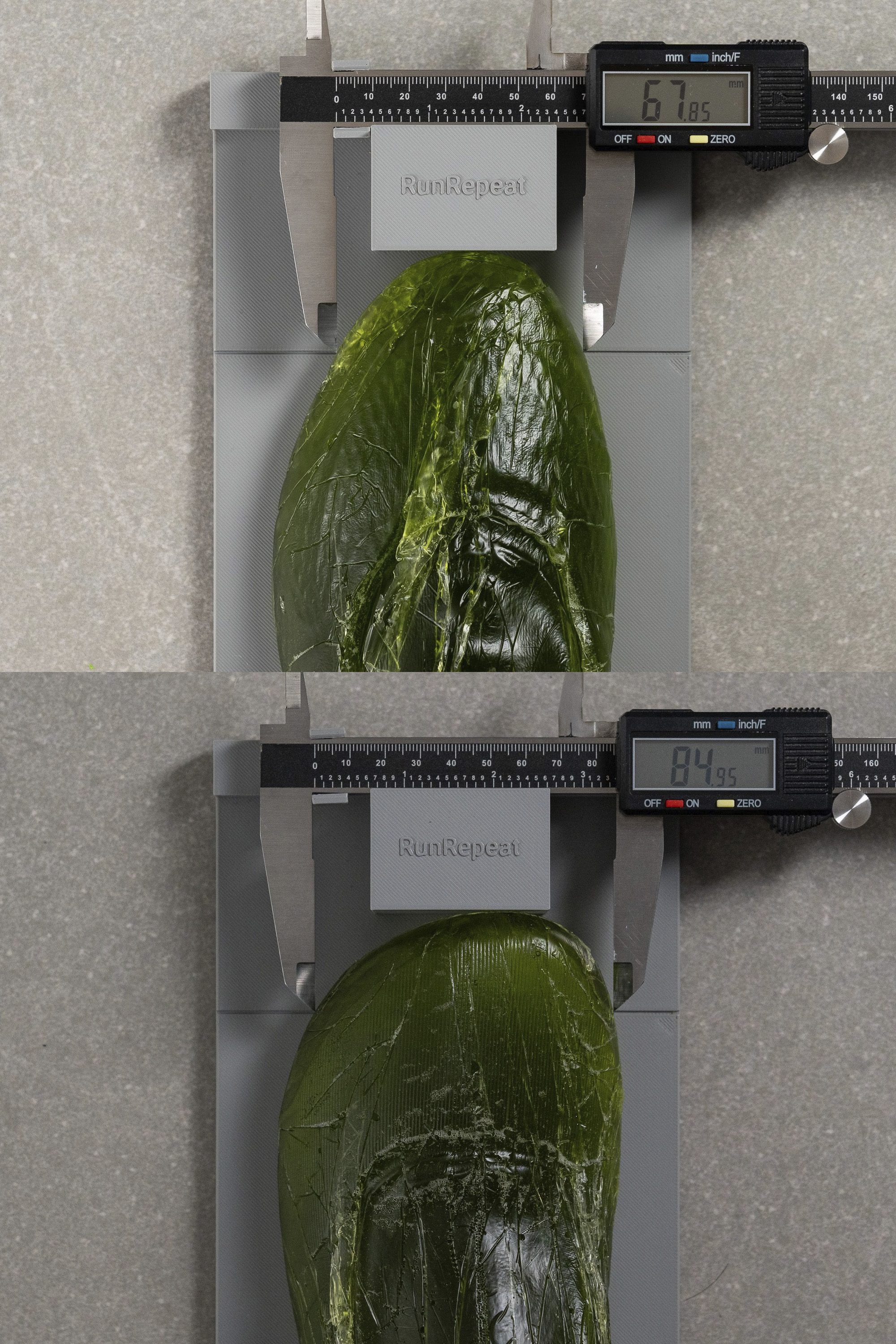
But also, when a bunion appears, it happens lower at the base of the big toe, so you need room where the ball of the foot is. This implies that you should look for the overall-wide toebox!
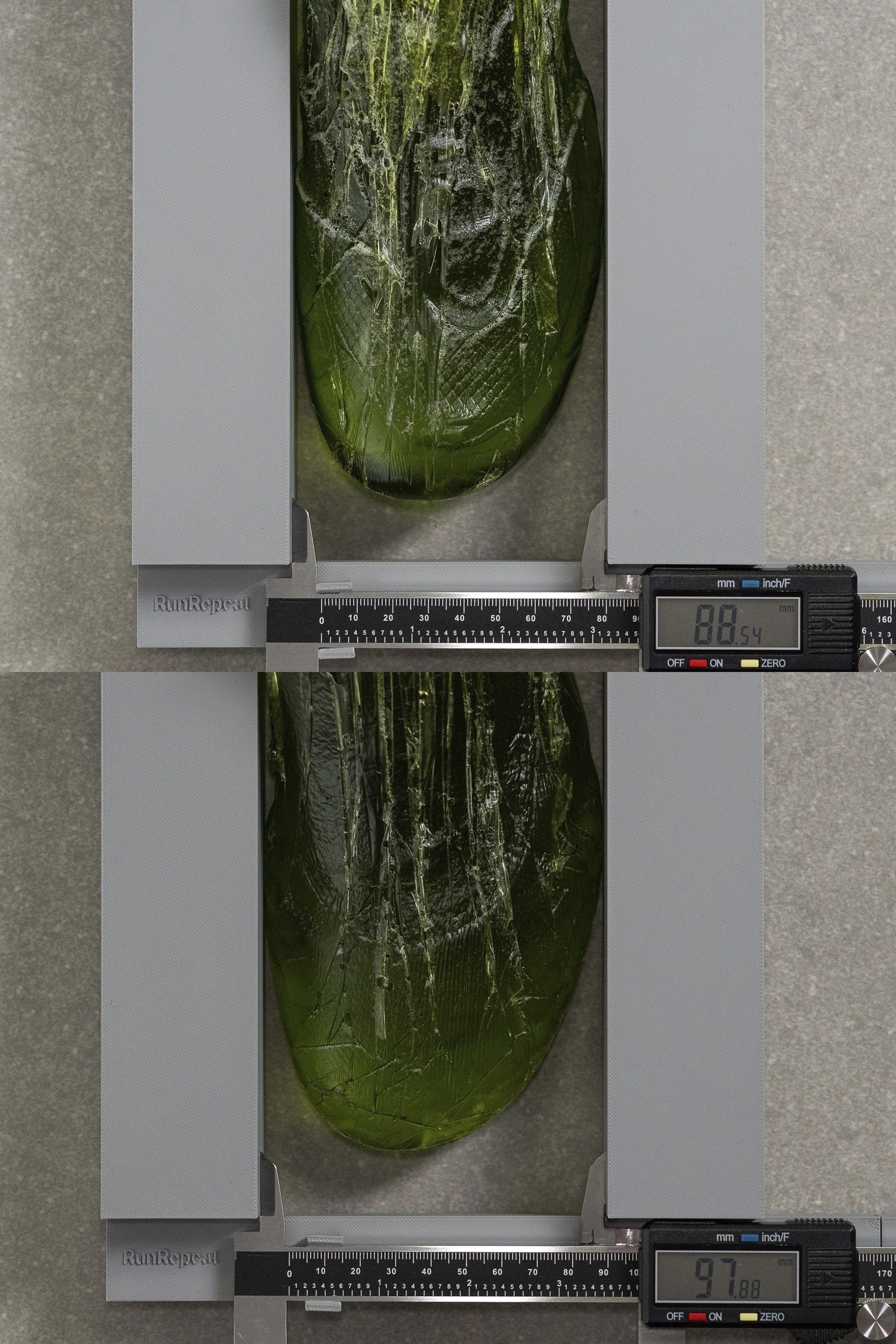
What you should avoid at all costs is a pointy (very tapered) toebox.
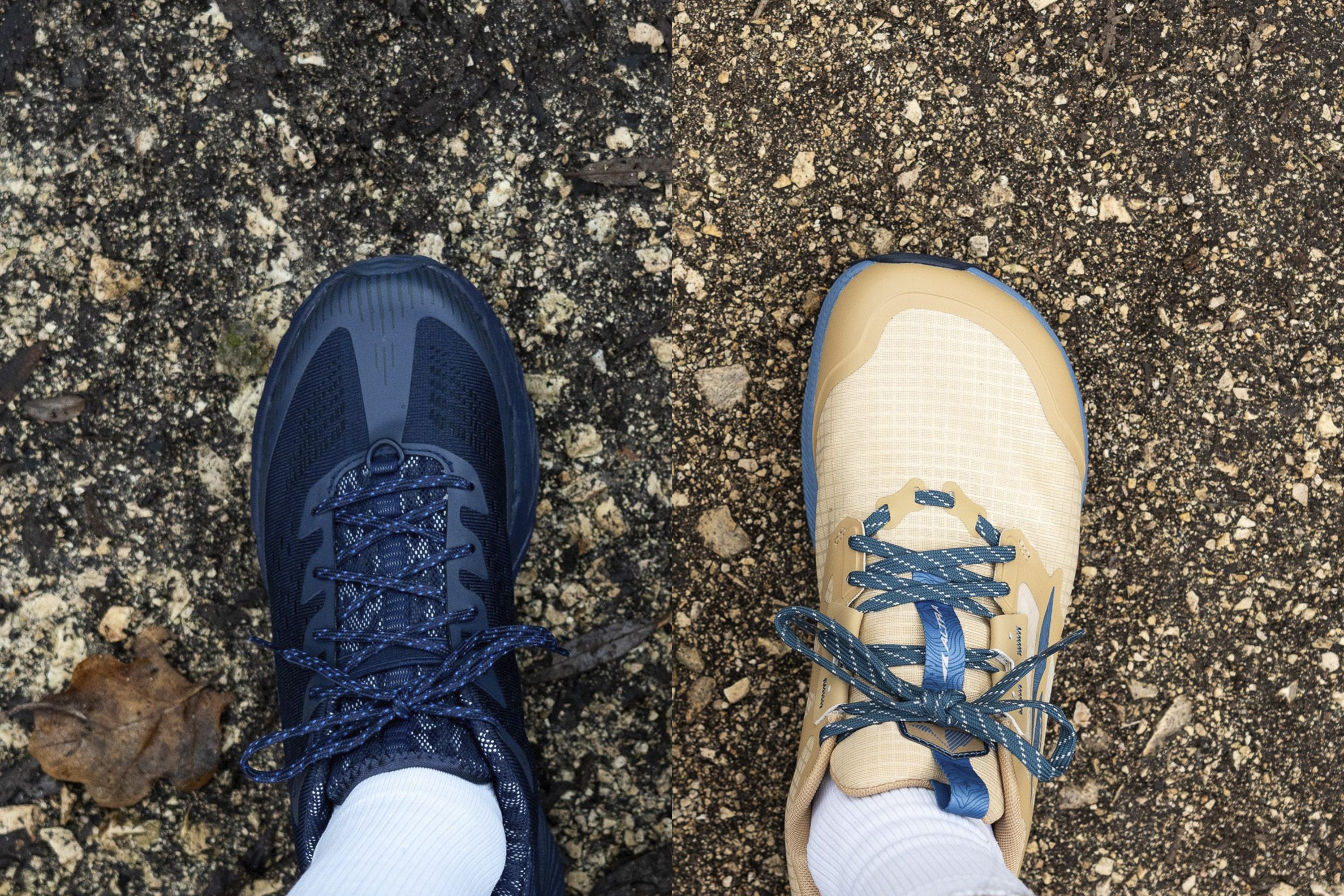
Overall, brands like Altra and Topo are known for their wide toeboxes. However, you might be ok with a few other models that have a wide toebox, because your feet could be generally on the narrow side, so you might not need as much space.
Finding a tall toebox in running shoes for bunions
Unfortunately, brands don’t publish this. Some will offer “shoe volume” or “toebox volume” but we don’t know how that volume is distributed.
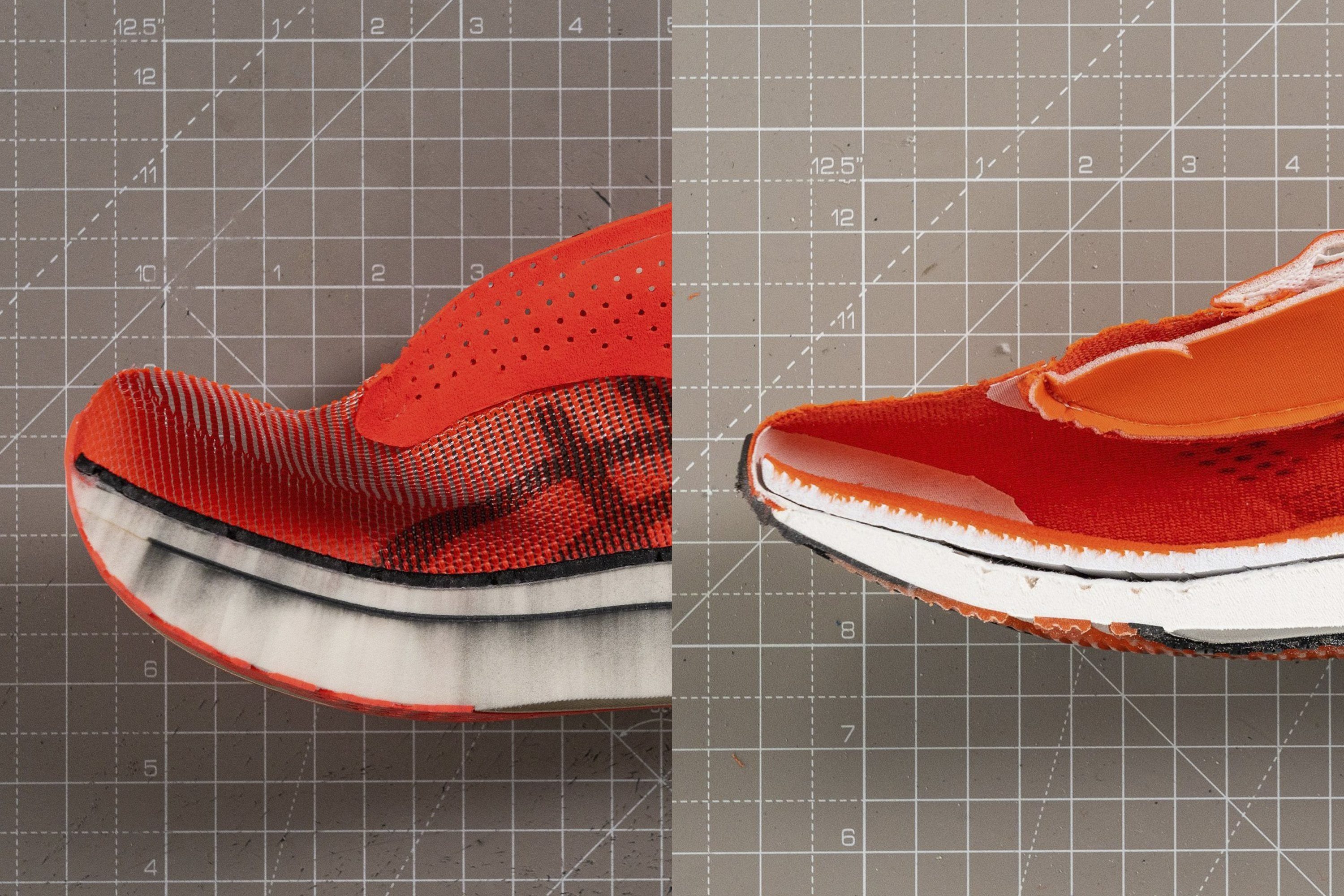
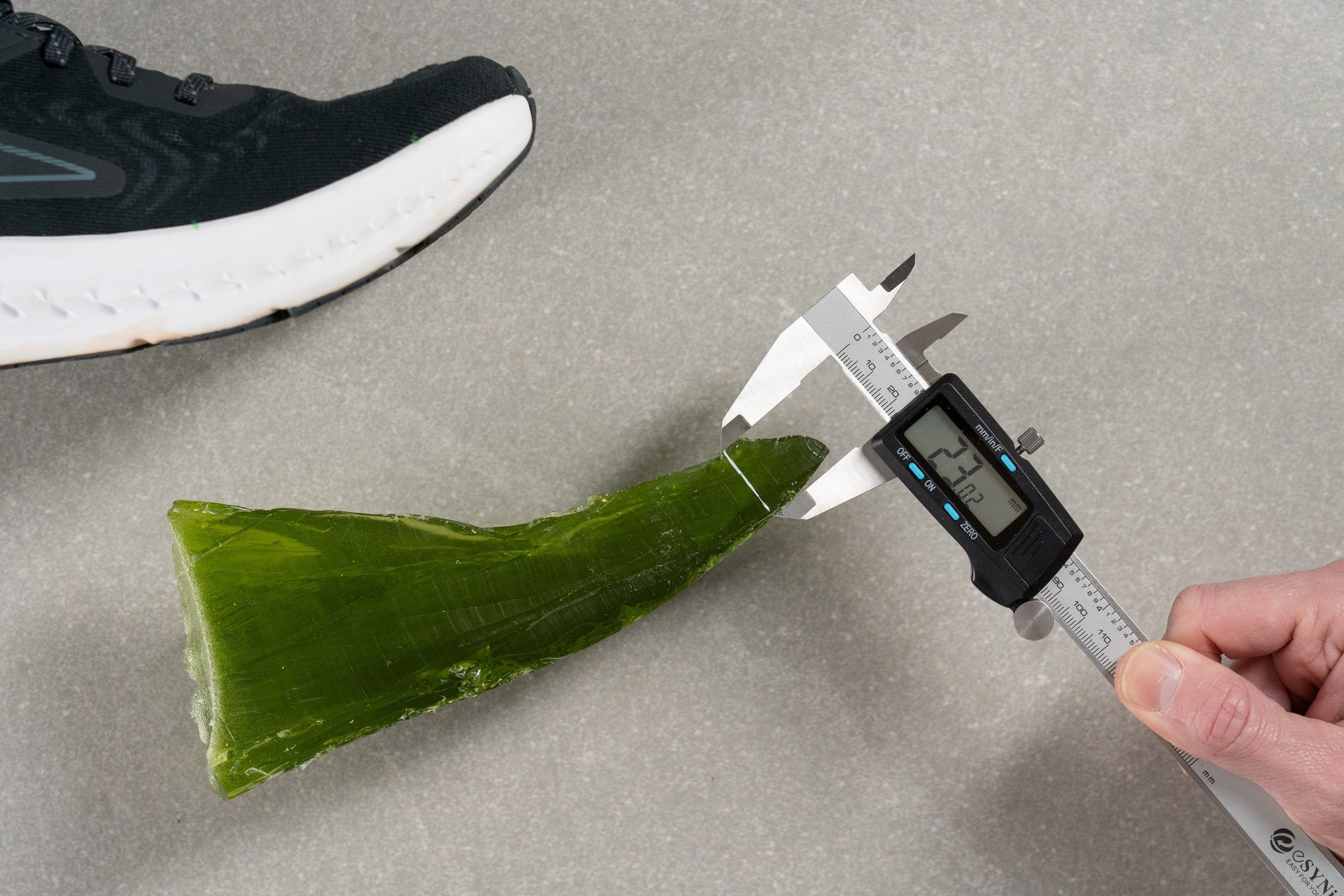
Having a stretchy upper can help here. When the big toe points up, a stretchy/soft upper will not put too much pressure on it, so runners can avoid having black toenails or toe injuries
Stretchy upper feels gentle when you have bunions
In short: look for a knit upper because it is comfortable and stretchy, creates the much-wanted sock-like feel, and is much less prone to blisters than the mesh upper. It helps when the base itself is not wide enough and your toes and bunions need more room.
There are mesh uppers that are stiffer and can be harsh for the bunions, and there are stretchy and comfy uppers made out of knit. They both have their pros and cons and, in general, there’s no good and bad, as their use depends on the shoe’s purpose.
Examining a soft knit upper in RunRepeat lab
However, when it comes to the bunions, it’s best to choose a knit one. This is to avoid any additional pressure on the bunion that would hurt or make the condition worse.
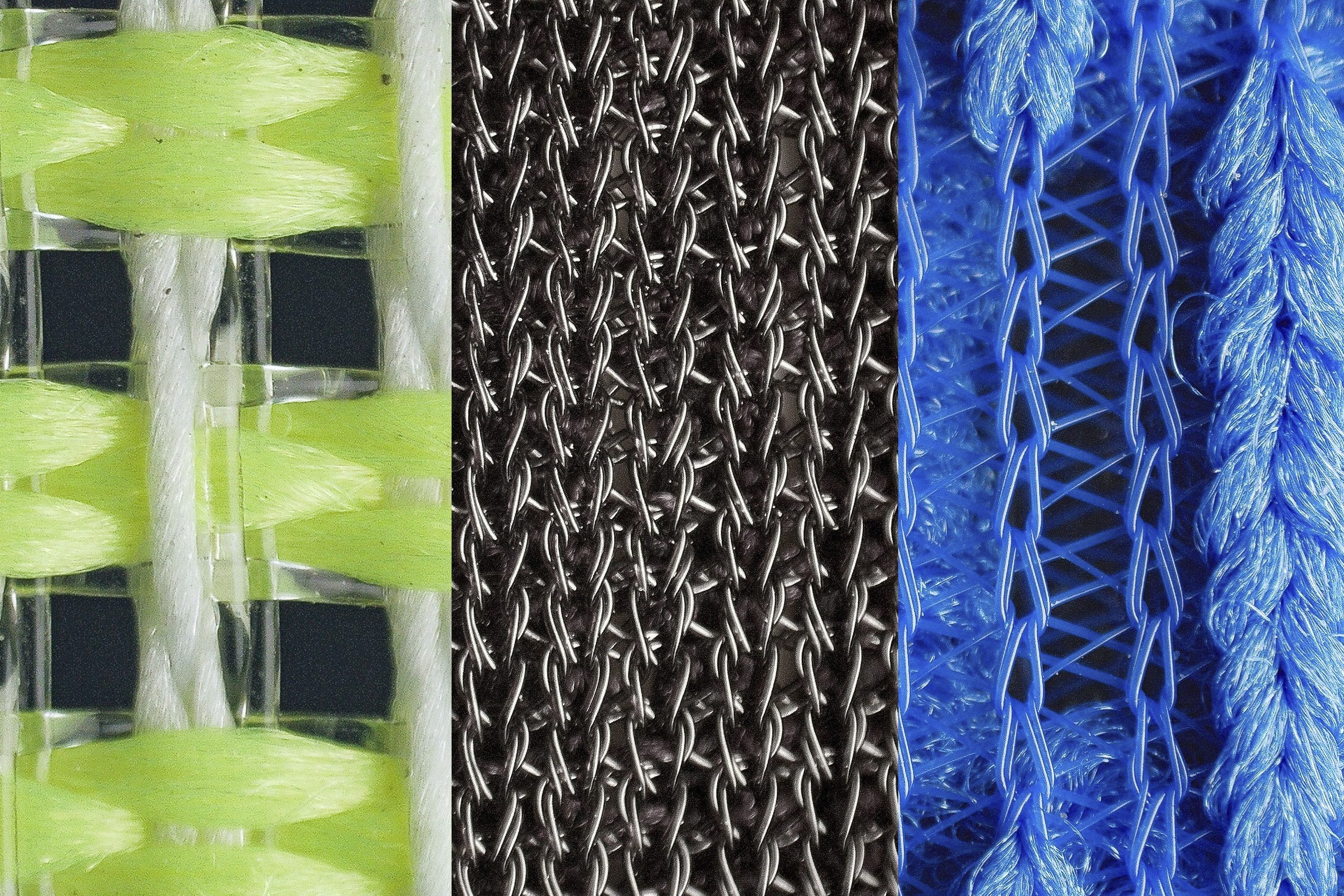

However, some toeboxes are wide already and you may not need more room that a knit upper would allow by being stretchy. Such toeboxes may feature a mesh upper as the table below shows.
Nailing the comfort in running shoes for bunions
While this is a given for most runners, once you get a bunion or bunions, you have to pay more attention to the comfort so that you don’t irritate the bunion more. This means you should look for running shoes in which:
- There are no pressure points or hot spots. Look for a comfortable shoe that does not put pressure on your feet, especially on the forefoot.
- You’re experiencing a superb lockdown. Your feet are not sliding backward-forward or left-right inside the shoe. Your heel should not be slipping as well.
Heel slipping should be avoided at all costs
Contradictory data on arch support and cushioning for bunions
There are studies and reports on both a) very cushioned shoes with arch support and b) minimalist or even barefoot shoes helping runners with bunions. Why is it so? Because runners have different needs depending on their pronation and the current state (progression) of bunions.
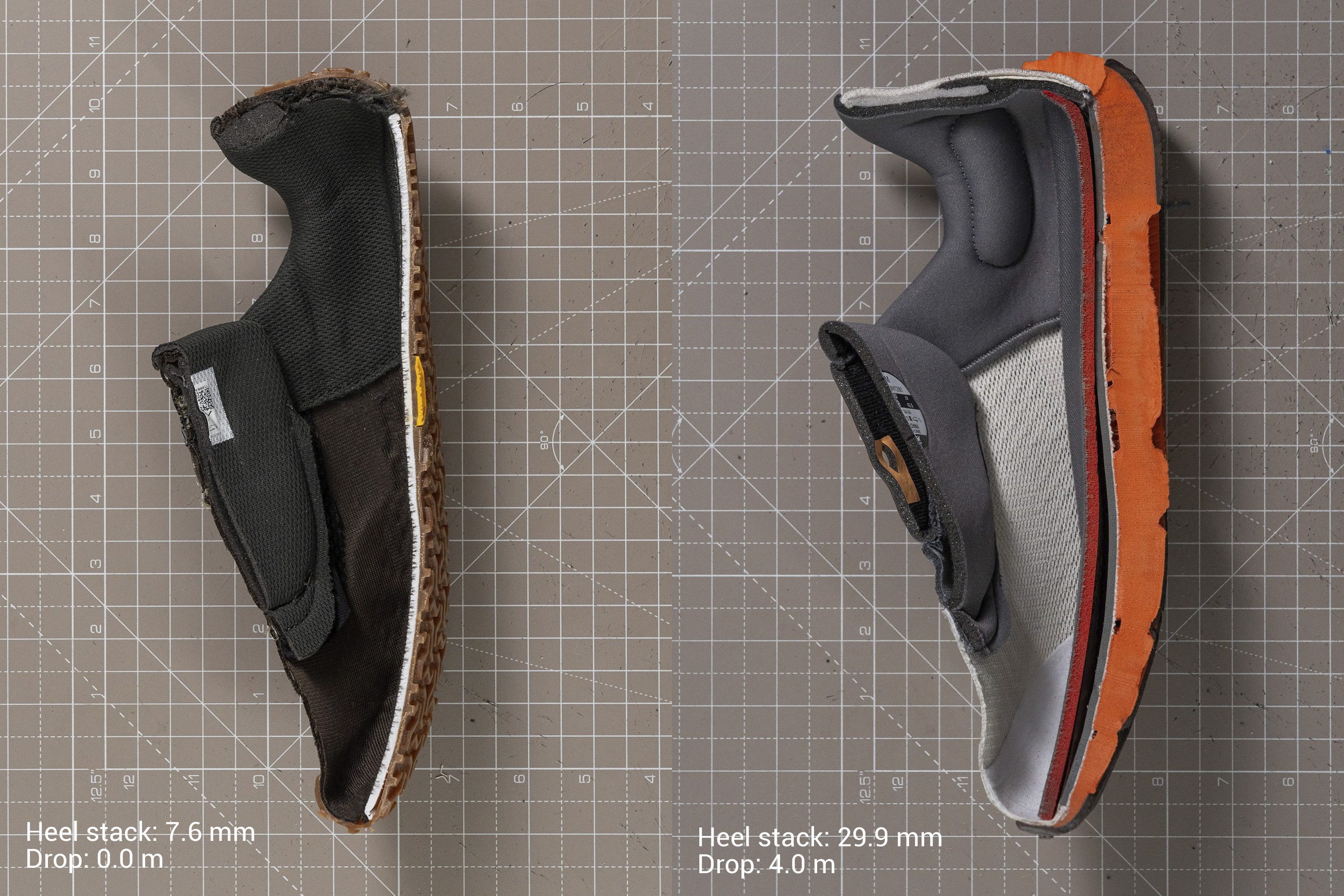
Here’s an overview of those 2 approaches:
|
Cushioned running shoes with arch support |
Barefoot running shoes |
|
Arch support lowers the pressure on the ball of the foot |
No arch support helps with foot muscle strengthening |
|
Study that found benefits of minimalist running shoes for bunions |
|
|
A lot of cushioning allows for impact protection and feels gentle toward the feet |
Minimal (or no) cushioning allows the feet to sense the ground and adapt to it. This makes the feet work more but with room to splay and enough (minimal) protection |
|
Runners are used to cushioned running shoes |
Moving to barefoot running shoes asks for patience (transition period that is often long) |
|
Can be used regardless of the distance |
Usually used for shorter distances, especially at the beginning (when getting used to them) |
|
Rockered running shoes can help with limited big toe movement or forefoot pain, so some runners with bunions enjoy rockered shoes |
Barefoot shoes can not feature a rocker and runners must rely on their own feet, not shoe technologies |
|
Runners who overpronate (or have flat feet) tend to enjoy cushioned running shoes with arch support |
Runners who have neutral pronation or who supinate have easier times transitioning to the barefoot running shoes as they don’t need the support and stability the overpronators need |
Shock absorption of running shoes for bunions
We consider running shoes cushioned when their shock absorption is higher than 110 SA. Shock absorption tells us how protective the midsole is or how good it is at dampening the impact at each landing. The higher the shock absorption, the better, because we really want to avoid any extra stress sent to the legs.
Testing the shock absorption of running shoes for bunions. We perform the test both at the forefoot and the heel so you can look for the numbers that you prioritize depending on your foot strike
Knowing that 110 SA of shock absorption is enough, it is up to you to decide how soft you want the shoes to be, and which heel drop to look for.
Softness of running shoes for bunions
Softer shoes are great because they mean more cloud-like feeling, as if there’s a gentle cushion below your feet. However, somewhat firmer shoes offer more stability and support that your feet will enjoy, especially if you’re overpronating.
When it comes to the softness, we measure it in our lab so you can consult our lab data. We use a shore A durometer to do this and we perform this test on a shoe cut in half as any other option would result in inaccurate measurements.
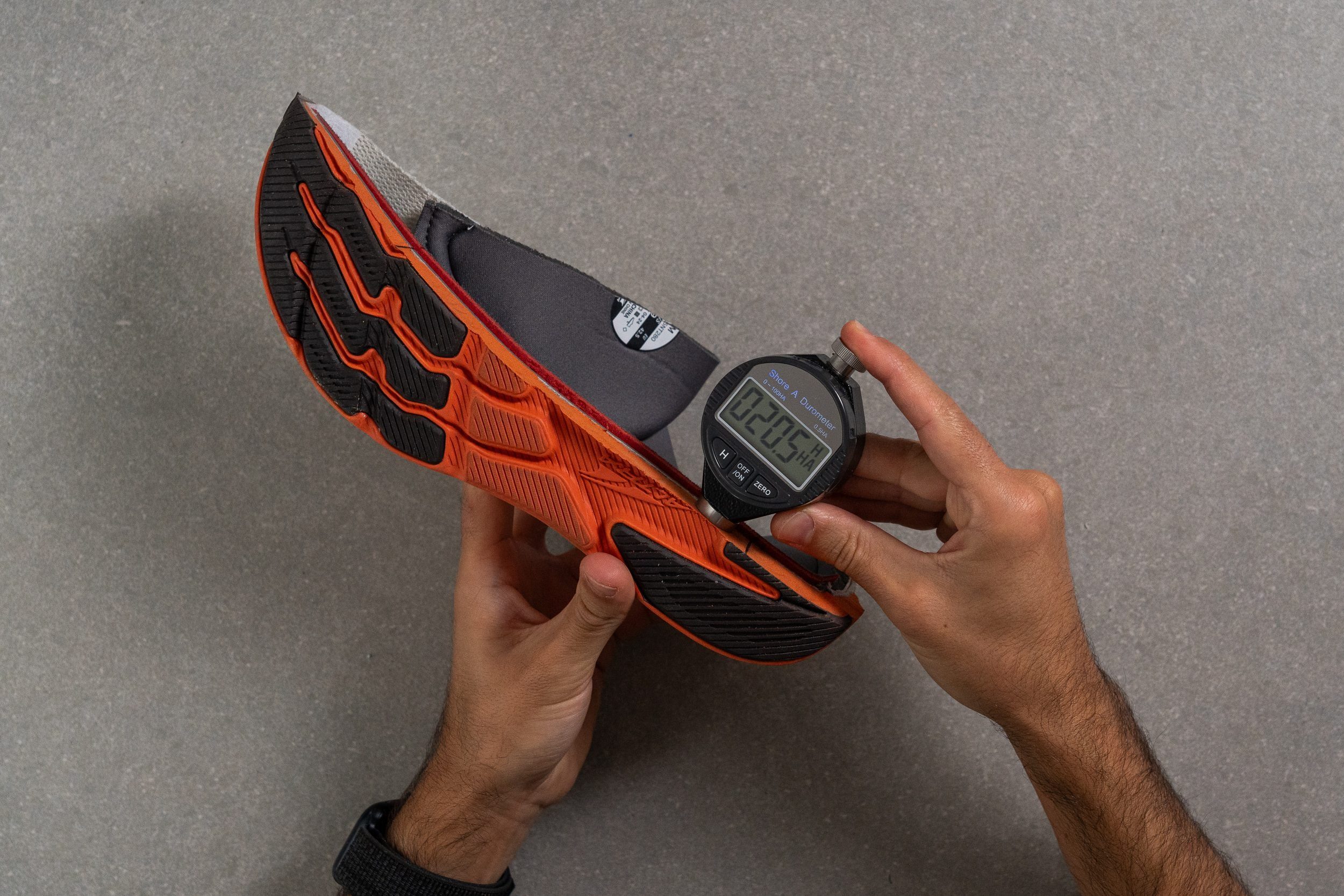
Looking at the display on the durometer, lower numbers indicate it’s a softer foam, while higher numbers indicate it’s a firmer foam.
It’s also worth noting that you can choose between a premium and a standard foam. Premium foams are usually found in tempo and race shoes, they offer an insane energy return and leg-saving features, but that comes at a price, literally.
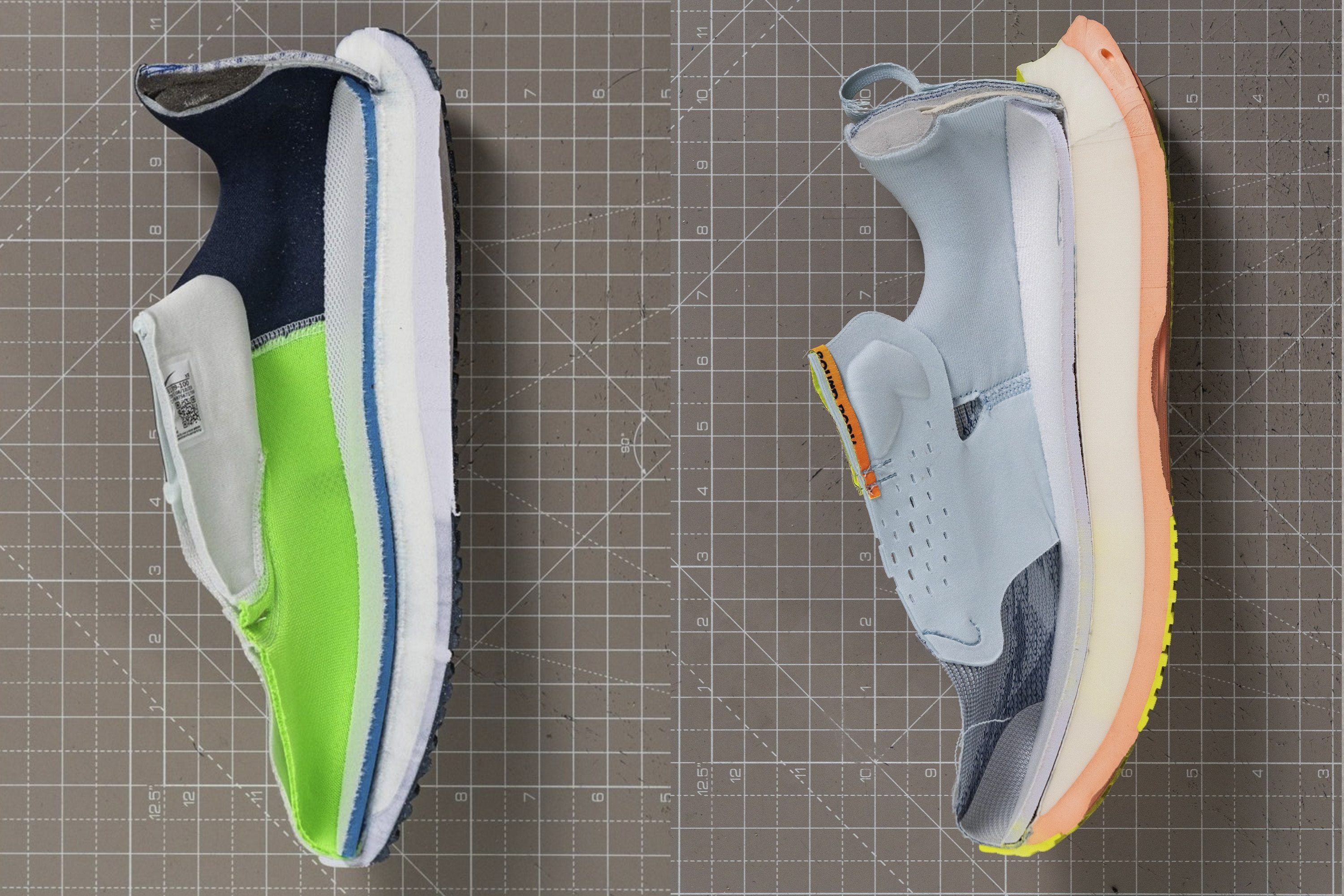
On the other hand, standard foams are usually found in daily trainers and they are known for their durability, affordability, and stability. If you have a preference or want to learn more about foams (basically all the geeky details), check out our Ultimate guide to running shoe foams.
Which heel drop should you choose if you have bunions
First, we should understand the effects of different heel-to-toe drops. Heel drop is the difference in height between the heel and the forefoot. We have flat shoes with a zero drop and high-drop running shoes with a drop as high as 16mm.
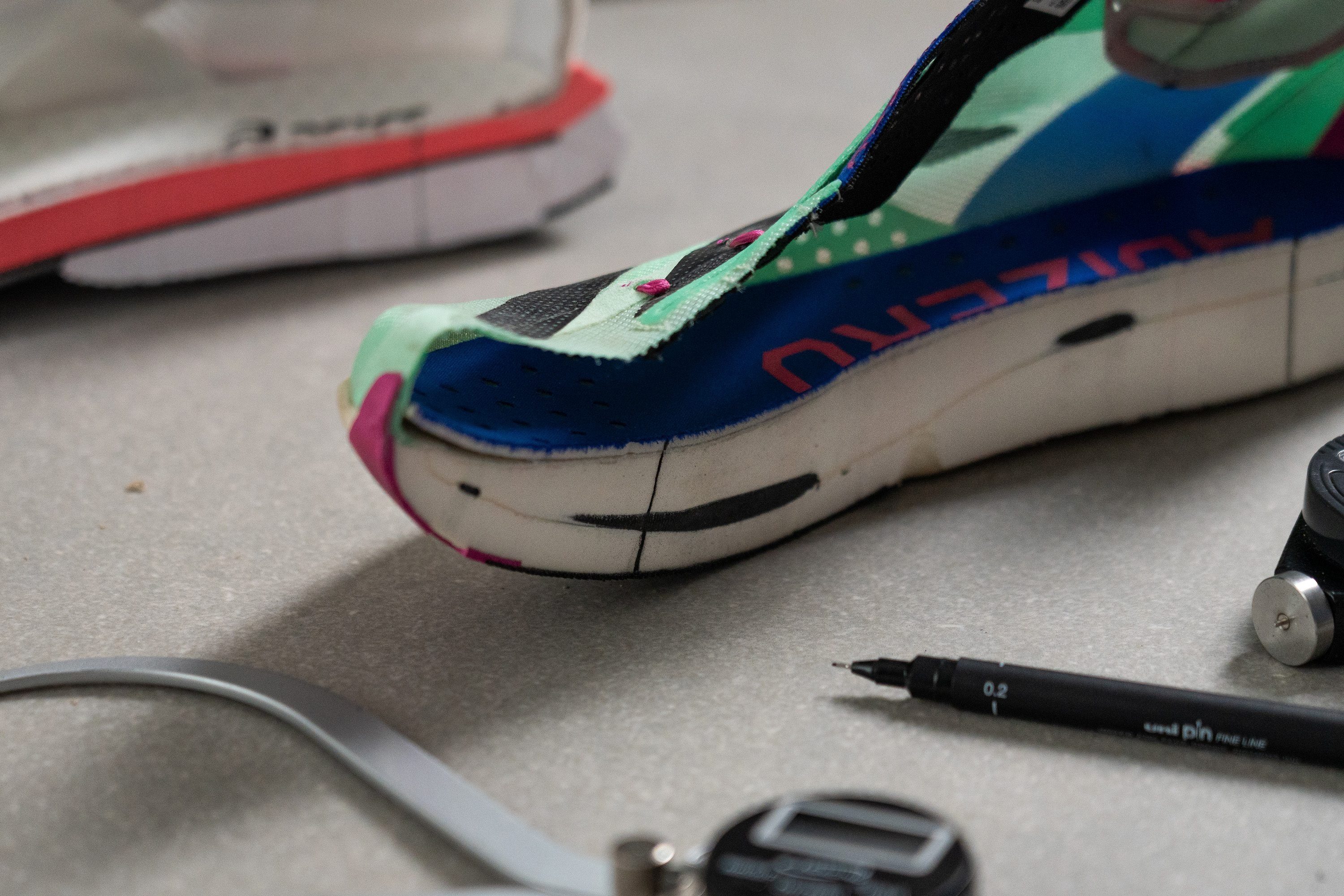
Based on the height, heel drop is split into 4 categories and each has different effects on the leg muscles:
- Zero drop (0mm): These shoes utilize the foot muscles the most. Many barefoot and minimalist running shoes feature a low drop. In the world of highly cushioned shoes, Hoka shoes sometimes feature a low drop.
- Low drop (1-4 mm): Shoes with a low drop use the lower-leg muscles the most (achilles, calves). Low drop and zero drop shoes put more stress on the foot that mid- and high-drop ones.
- Mid drop (5-8 mm): These shoes utilize the muscles round the knee and quads the most.
- High drop (9mm and higher): Wearing high drop running shoes means you will be using muscles around the hips a lot.
Knowing this, it’s on you to figure out which drop would suit you best. Heel strikers usually enjoy a higher drop because such shoes (obviously) have more cushioning at the heel. Forefoot strikers don’t need the chunky heel so they choose flatter shoes, and it works vice versa as well. Lower drops promote forefoot striking.
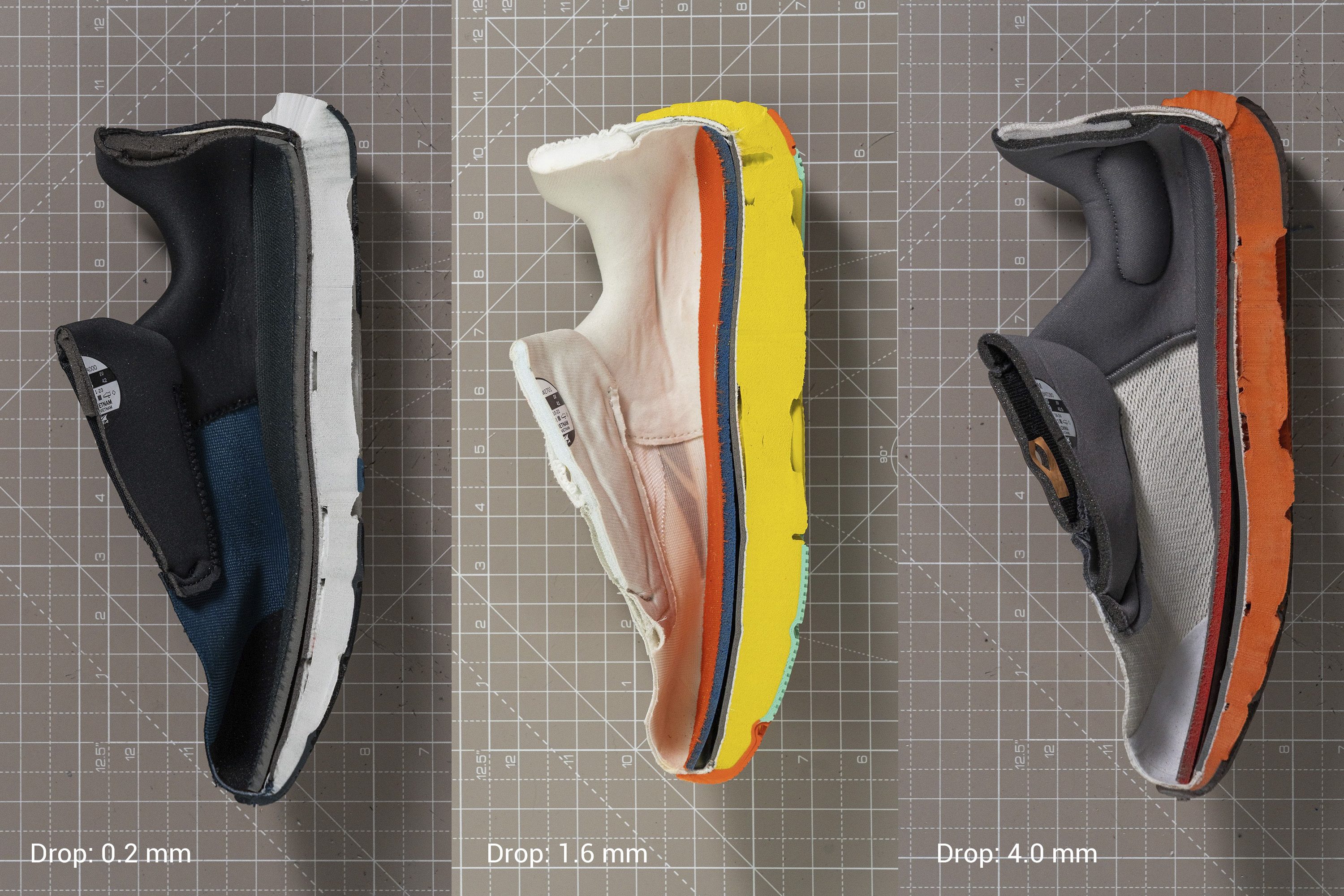
If you’re choosing minimalist or barefoot shoes (covered in the next chapter), you will most likely go for a low or zero drop. In cushioned running shoes, it depends on the goal. If you want to alleviate all the extra stress on the foot muscles, you can choose a higher drop. However, if using foot muscles works better for you (definitely not painful!) you may choose a lower drop.
Here, we’ve covered the basics only. For more useful information, we recommend reading our ultimate guide on heel to toe drop.
Minimalist and barefoot running shoes for runners with bunions
There’s quite a big difference between minimalist and barefoot running shoes, although they are often put in the same group. In barefoot running shoes, there are no stabilizing technologies, upper usually has no structure, they are as flexible as they get. Minimalist running shoes, however, feature some cushioning and can have some structural or stiff elements.
Crazy level of flexibility found in a barefoot running shoe
If you plan to use these shoes, this is our advice:
- Take time to adjust to the minimalist or barefoot footwear. It might take months because it might be your first time walking and running in shoes with barely any or no cushioning and protection. Also, it takes quite a lot of time to transition from, say 10mm drop, to a zero- or low-drop!
- If you’re an overpronator, be even more cautious. You might do better in minimalist shoes than barefoot shoes, as they have at least some cushioning to absorb the impact forces of your uneven landing.
- It’s best to just start walking shorter distances in these shoes and up the mileage gradually. Whenever you feel the pain, stop immediately. IF you’re far from home, rest and change to your old shoes (cushioned/high drop) to get back home. Do this, of course, in case your old shoes are causing you no pain or discomfort!
Good-to-know facts about bunions
Here are some facts we found interesting and useful while doing the research on bunions:
- Bunions affect around 35% of women over the age of 65.
- Bunions can be removed surgically. This surgery can improve the ability to walk and exercise and it can reduce the pain. However, up to 15% of bunions return.
- Strengthening the muscles may help with bunion-related pain and movement.
- More than 70% of people with bunions have a biological parent who’s had them
Sources
- https://pubmed.ncbi.nlm.nih.gov/27363573/
- https://my.clevelandclinic.org/health/diseases/14386-bunions-hallux-valgus
- https://pmc.ncbi.nlm.nih.gov/articles/PMC2615430/
- https://www.bunioninstitute.com/blog/difference-between-bunion-and-big-toe-arthritis/
- https://pubmed.ncbi.nlm.nih.gov/24515981/
- https://pubmed.ncbi.nlm.nih.gov/30558948/
- RunRepeat lab data

